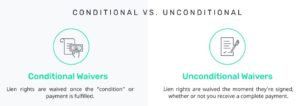Everyone on a construction project benefits from lien waivers as they are an important tool in the construction payment process. Lien waivers are the release of lien rights up to a predetermined dollar amount. This is usually done once payment has been received by the contractor, sub or supplier. No one wants to deal with a mechanics lien when they are at the top of a project, so lien waivers are a critical piece to show a receipt of payment.
Here’s an example of how they are used: A general contractor pays a subcontractor for laying tile. The subcontractor then signs a lien waiver, giving up his lien rights on the amount that they were paid.
They sound simple and straightforward, but actually, these documents can be quite elaborate and long. It’s important for everyone to understand the different types of waivers and how they work.
Different Types of Lien Waivers
There are 4 common types of lien waivers used across the US and it’s important to know which ones to use in specific situations, and most can be broken down into two categories – conditional and unconditional.

Conditional Waivers
Conditional waivers are signed by the owner or contractor receiving services. Once you have completed the work and received payment, the condition has been met. There are two types of conditional waivers that can be used.
Conditional Partial Payment
Conditional partial payment waivers are used when you expect regular progress payments throughout your work on the job. Once the money is hin have, you commit to lien rights for work performed up to that point. These can be signed in advance without risking your lien rights.
Conditional Final Payment
These types of conditional waivers should only be used when you are expecting your final payment-in-full for what you are owed on the project. They are deemed invalid if you do not receive a complete payment, so you can retain your lien rights.
Unconditional Waivers
In unconditional waivers, lien rights are waived the moment they’re signed – regardless of if you’ve received payment. Similar to conditional waivers, there are also two unconditional waiver options, unconditional partial payment, and unconditional final payment.
Unconditional Partial Payment
This type of waiver is used exclusively when you are expecting regular progress payments and want to release your lien rights for work you have already been paid for. It’s effective as soon as it’s signed and therefore should be executed only when you have the payment in hand.
Unconditional Final Payment
These lien waivers should only be signed upon completion of the project and receipt of final payment. They are a formal release of all lien rights without protection and should therefore be executed and signed ONLY once you have the money in hand and in the bank.
It’s important to note that not every state regulates lien waivers. In fact, only 12 states have set requirements in place on what must be included in those documents, and if not followed to it’s exactness, it can could result in a penalty. Be sure to read up on your specific state to learn more.
At Titan Lien Services, we ensure your work is protected by verifying and filing all required documents needed to secure your lien rights. As an added benefit, we also generate lien wavers for free for anyone who uses our portal.